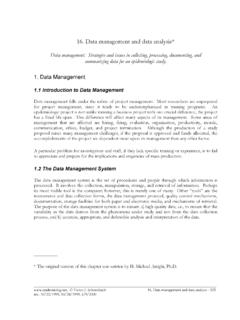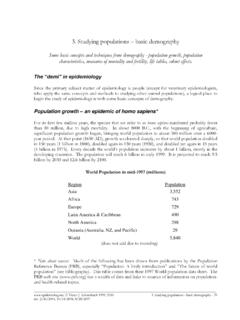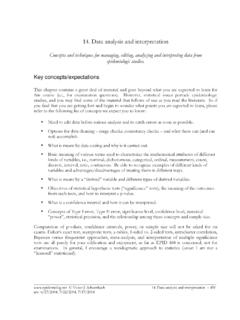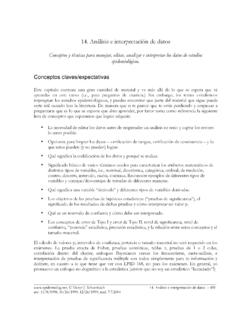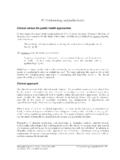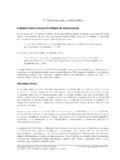Transcription of Fundamentals of epidemiology - an evolving text
1 Understanding the Fundamentals ofEpidemiologyan evolving text_____Victor J. Schoenbach, D. Rosamond, of EpidemiologySchool of Public HealthUniversity of North Carolina at Chapel HillFall 2000 Edition 1999, 2000 Victor J. SchoenbachUnless otherwise indicated, the text and diagrams in this work belong to the copyright owner reprint permission (royalty-free for noncommercial use by nonprofit, accredited, educationalorganizations), please write to:Victor J. Schoenbach, of EpidemiologyUniversity of North CarolinaSchool of Public HealthChapel Hill, NC 27599-7400 to reprint material copyrighted by others and used here by their permission must beobtained directly from 1999, 2000 Chapel Hill, North , Victor J. Schoenbach 1999, 2000rev.
2 9/26/1999, 8/20/2000, 3/9/20011. epidemiology Definition, functions, and characteristics - 1 PrefaceIntroductory epidemiology courses are often referred to as "methods" courses, and many studentscome to them hoping to learn the methods that have made epidemiology so important. Certainlymethods are an essential aspect of the field, and this text covers the usual complement. Butespecially for the newcomer, the critical need is to learn how epidemiologists think about health andthe factors that affect it, and how epidemiologists approach studying them. Very few methods areunique to epidemiology . "Epidemiologic thinking" is its essence. Therefore, for me the centralobjective of an introductory course has been to explain the concepts and perspectives of the nearly 20 years I have had the privilege of teaching the introductory epidemiology course forepidemiology majors at the University of North Carolina School of Public Health and the specialpleasure that derives from teaching students who have sought epidemiology out rather than come tolearn it only as a school requirement.
3 I have also had the honor of being entrusted by my colleagueswith the responsibility for introducing our students to epidemiologic concepts and the years I have written out extensive lecture notes, initially in response to requests fromcourse participants and subsequently to develop my own understanding. Not all course participantshave appreciated them, but I have received sufficient positive feedback and expressions of interestfrom graduates who have gone on to teach their own epidemiology courses that I have decided torecast them as an " evolving text". I use the term " evolving " because I continue to clarify, develop,refine, correct, and, I hope, it as an evolving text is also my excuse for the fact that the material is not ready forformal publication.
4 Moreover, unlike a published text, this volume does not claim to beauthoritative nor even thoroughly proofread. As an evolving work, its further development hasalways taken priority over appearance and, it must be admitted, occasionally also over accuracy.*Although the word processing is nearly all my own, the content is certainly not. Besides theextensive development and exposition of epidemiologic concepts and methods from courses andpublications by others, I have had the good fortune to study with and learn from outstandingepidemiologists and biostatisticians, among them the late John Cassel, Gerardo Heiss, BarbaraHulka, Michel Ibrahim, Sherman James, Bert Kaplan, David Kleinbaum, Gary Koch, LawrenceKupper, Hal Morgenstern, Abdel Omran, the late Ralph Patrick, Dana Quade, David Savitz, CarlShy, the late Cecil Slome, Tyroler, and Edward Wagner.
5 * Important errata, as I learn about them, are posted on a site on the World Wide Web ( ). , Victor J. Schoenbach 1999, 2000rev. 9/26/1999, 8/20/2000, 3/9/20011. epidemiology Definition, functions, and characteristics - 2My thinking and this text have also greatly benefited from interactions with other colleagues andteachers, co-instructors, teaching assistants, collaborators, associates, research staff, fellows, andstudents. I must particularly acknowledge the assistance of Charles Poole, who has generouslyshared his expertise with me through his advanced methods course and frequent consultations. Hehas even made the ultimate sacrifice reading this text and sitting through my lectures!
6 The content(errors excepted!) and to some extent the exposition, therefore, represent the knowledge, ideas,examples, and teaching skills of many people, to a much greater extent than the specific attributions,citations and acknowledgements would are of greater interest to authors than to readers, and I ask your forgiveness forincluding several more. I received my own introduction to epidemiology from the late John Cassel -- intellectual pioneer, inspiring lecturer, and humanist -- and Bert Kaplan -- quintessential scholar,supporter, and friend, whose colleagueship, breadth of knowledge, depth of wisdom, dedication tothe ideals of the academy, and personal warmth have enriched the lives of so many. I would alsolike to express my gratitude to colleagues, staff, secretaries (especially Pat Taylor, Edna MackinnonLennon, and Virginia Reid), students, administrators, and family for inspiration, stimulation,feedback, opportunity, advice, guidance, commitment, counseling, assistance, support, affection, anda good deal epidemiology !
7 Victor J. SchoenbachChapel Hill, North 17, 1999 Postscript: After the 20th anniversary edition of EPID 168 (" Fundamentals of epidemiology "), myteaching responsibilities have changed to its sister course, EPID 160 ("Principles of epidemiology ").EPID 160 serves as the basic introductory course for all students, graduate and undergraduate, whoare not majoring in epidemiology . Thus its audience is much more diverse in both interests andpreparation. Time will tell if I am able to continue to refine the evolving Text, but if so it will beginto move in the direction of making it more suitable for a general and international readership. Ihave been gratified by the expressions of interest in it in its present form and hope that it willcontinue to be of use to 9, of ContentsChapter (in Acrobat , click on a chapter name to move to that page) Page* 11.
8 epidemiology Definition, functions, and characteristics .. 32. An evolving historical perspective .. 173. Studying populations - basic demography .. 31 Assignment .. 53 Solutions .. 574. The Phenomenon of Disease .. 595. Measuring Disease and Exposure ..81 Appendix on weighted 113 Appendix on logarithms .. 115 Assignment .. 117 Solutions .. 1236. Standardization of rates and 129 Assignment .. 149 Solutions .. 1537. Relating risk factors .. 199 Assignment .. 201 Solutions .. 2058. Analytic study designs .. 209 Assignment .. 257 Solutions .. 2659. Causal inference .. 26910. Sources of error .. 287 Appendices .. 319 Assignment .. 325 Solutions .. Victor J. SchoenbachTable of contents8/2/100111. Multicausality Confounding.
9 335 Assignment .. 373 Solutions .. 37712. Multicausality Effect modification .. 381 Assignment .. 413 Solutions .. 41713. Multicausality Analysis approaches .. 423 Assignment (see next chapter)14. Data analysis and interpretation .. 451 Assignment .. 499 Solutions .. 50315. Practical aspects of epidemiologic 50716. Data management and data analysis .. 52317. epidemiology and public 55118. Overview and Conclusion .. 565* Note: page numbers do not exactly match the number of the physical page because ofunnumbered pages and are not in exact sequence because of chapter revisions or pages insertedfrom other sources ( , published articles for assignments).Index: although no index is available, the Acrobat Reader has powerful search capabilities (seethe Edit Menu).
10 You can search through all chapters at once by viewing the PDF that contains allof the chapters and assignments in a single epidemiology learning materials and resources, including practice examinations, may be foundat , Victor J. Schoenbach 1999, 2000 rev. 3/9/2001, 5/3/2003, 9/25/2003 1. epidemiology Definition, functions, and characteristics - 3 1. epidemiology Definition, functions, and characteristics Definition, characteristics, uses, varieties, and key aspects of epidemiology * What to tell your family and friends When your family or friends ask what you are studying, and you say epidemiology , the response is often something like: You re studying what? Does that have something to do with skin?

